International Space Station
 |
||
| The International Space Station on 23 May 2010 as seen from the departing Space Shuttle Atlantis during STS-132. | ||
 |
||
| ISS Insignia | ||
| Station statistics | ||
|---|---|---|
| NSSDC ID | 1998-067A | |
| Call sign | Alpha | |
| Crew | 6 | |
| Launch | 1998–2011 | |
| Launch pad | KSC LC-39, Baikonur LC-1/5 & LC-81/23 |
|
| Mass | 369,914 kg (815,520 lb) | |
| Length | 51 m (167.3 ft) from PMA-2 to Zvezda |
|
| Width | 109 m (357.5 ft) along truss, arrays extended |
|
| Height | c. 20 m (c. 66 ft) nadir–zenith, arrays forward–aft (27 November 2009) |
|
| Pressurised volume | 837 m3 (29,561 cu ft) |
|
| Atmospheric pressure | 101.3 kPa (29.91 inHg, 1 atm) | |
| Perigee | 347 km (187 nmi) AMSL (18 June 2010) |
|
| Apogee | 360 km (194 nmi) AMSL (18 June 2010) |
|
| Orbital inclination | 51.6 degrees | |
| Average speed | 7,706.6 m/s (27,743.8 km/h, 17,239.2 mph) |
|
| Orbital period | 91 minutes | |
| Days in orbit | 4469 (13 February 2011) |
|
| Days occupied | 3758 (13 February 2011) |
|
| Number of orbits | 70148 (13 February 2011) |
|
| Orbital decay | 2 km/month | |
| Statistics as of 23 May 2010 (unless noted otherwise) |
||
| References: [1][2][3][4][5] | ||
| Configuration | ||
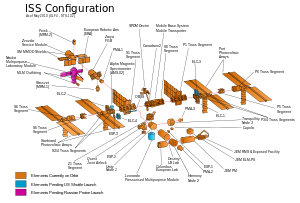 |
||
| Station elements as of 18 May 2010[update] (exploded view) |
||
The International Space Station (ISS) is an internationally developed research facility that is being assembled in low Earth orbit. On-orbit construction of the station began in 1998 and is scheduled for completion by late 2011. The station is expected to remain in operation until at least 2015, and likely 2020.[6][7] With a greater cross-sectional area than that of any previous space station, the ISS can be seen from Earth with the naked eye,[8] and is by far the largest artificial satellite that has ever orbited Earth.[9] The ISS serves as a research laboratory that has a microgravity environment in which crews conduct experiments in biology, chemistry, human biology, physics, astronomy and meteorology.[10][11][12] The station provides a unique environment for the testing of the spacecraft systems that will be required for missions to the Moon and Mars.[13] The ISS is operated by Expedition crews, with the station programme maintaining an uninterrupted human presence in space since the launch of Expedition 1 on 31 October 2000, a total of 10 years and 106 days. The programme is thus approaching the current record for uninterrupted human presence on a space station, set aboard Mir, of 3,644 days (8 days short of 10 years), with the ISS expected to take the record on 23 October 2010.[14] As of 1 June 2010[update], the crew of Expedition 24 is aboard.[15]
The ISS is a synthesis of several space station projects that include the American Freedom, the Soviet/Russian Mir-2, the European Columbus and the Japanese Kibō.[16][17] Budget constraints led to the merger of these projects into a single multi-national programme.[16] The ISS project began in 1994 with the Shuttle–Mir programme,[18] and the first module of the station, Zarya, was launched in 1998 by Russia.[16] Assembly continues, as pressurised modules, external trusses, and other components are launched by American space shuttles, Russian Proton rockets and Russian Soyuz rockets.[17] As of May 2010[update], the station consists of fourteen pressurised modules and an extensive integrated truss structure (ITS). Power is provided by sixteen solar arrays mounted on the external truss, in addition to four smaller arrays on the Russian modules.[19] The station is maintained at an orbit between 278 km (173 mi) and 460 km (286 mi) altitude, and travels at an average speed of 27,743.8 km/h (17,239.2 mph), completing 15.7 orbits per day.[20]
Operated as a joint project between the five participant space agencies, the station's sections are controlled by mission control centres on the ground operated by the American National Aeronautics and Space Administration (NASA), the European Space Agency (ESA), the Russian Federal Space Agency (RKA), the Japan Aerospace Exploration Agency (JAXA) and the Canadian Space Agency (CSA).[21][22] The ownership and use of the space station is established in intergovernmental treaties and agreements[23] that allow the Russian Federation to retain full ownership of its own modules in the Russian Orbital Segment,[24] with the US Orbital Segment, the remainder of the station, allocated between the other international partners.[23] The cost of the station has been estimated by ESA as €100 billion over 30 years,[25] and, although estimates range from 35 billion dollars to 160 billion dollars, the ISS is believed to be the most expensive object ever constructed.[26] The financing, research capabilities and technical design of the ISS programme have been criticised because of the high cost.[27][28] The station is serviced by Soyuz spacecraft, Progress spacecraft, space shuttles, the Automated Transfer Vehicle and the H-II Transfer Vehicle (HTV-II),[22] and has been visited by astronauts and cosmonauts from 15 different nations.[9]
Contents |
Purpose
The International Space Station (ISS) is an internationally developed satellite currently being assembled in Low Earth Orbit. Primarily a research laboratory, the ISS offers an advantage over spacecraft such as NASA's Space Shuttle because it is a long-term platform in the space environment, where extended studies are conducted.[9][29] The presence of a permanent crew affords the ability to monitor, replenish, repair, and replace experiments and components of the spacecraft itself. Scientists on Earth have swift access to the crew's data and can modify experiments or launch new ones, benefits generally unavailable on specialised unmanned spacecraft.[29]
Crews, who fly expeditions of several months duration, conduct scientific experiments each day (approximately 160 man-hours a week).[10][30] As of the conclusion of Expedition 15, 138 major science investigations had been conducted on the ISS.[31] Scientific findings, in fields from basic science to exploration research, are published every month.[13]
The ISS provides a location in the relative safety of Low Earth Orbit to test spacecraft systems that will be required for long-duration missions to the Moon and Mars. This provides experience in the maintenance, repair, and replacement of systems on-orbit, which will be essential in operating spacecraft further from Earth. Mission risks are reduced, and the capabilities of interplanetary spacecraft are advanced.[13]
Part of the crew's mission is educational outreach and international cooperation. The crew of the ISS provide opportunities for students on Earth by running student-developed experiments, making educational demonstrations, and allowing for student participation in classroom versions of ISS experiments, NASA investigator experiments, and ISS engineering activities. The ISS programme itself, with the international cooperation that it represents, allows 14 nations to live and work together in space, providing lessons for future multi-national missions.[22][32]
Scientific research

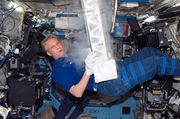
The ISS provides a platform to conduct experiments that require one or more of the unusual conditions present on the station. The primary fields of research include human research, space medicine, life sciences, physical sciences, astronomy and meteorology.[10][11][12] The 2005 NASA Authorization Act designated the American segment of the International Space Station as a national laboratory with the goal of increasing the use of the ISS by other federal agencies and the private sector.[33]
Research on the ISS improves knowledge about the effects of long-term space exposure on the human body. Subjects currently under study include muscle atrophy, bone loss, and fluid shift. The data will be used to determine whether space colonisation and lengthy human spaceflight are feasible. As of 2006, data on bone loss and muscular atrophy suggest that there would be a significant risk of fractures and movement problems if astronauts landed on a planet after a lengthy interplanetary cruise (such as the six-month journey time required to fly to Mars).[34][35] Large scale medical studies are conducted aboard the ISS via the National Space and Biomedical Research Institute (NSBRI). Prominent among these is the Advanced Diagnostic Ultrasound in Microgravity study in which astronauts (including former ISS Commanders Leroy Chiao and Gennady Padalka) perform ultrasound scans under the guidance of remote experts. The study considers the diagnosis and treatment of medical conditions in space. Usually, there is no physician onboard the ISS and diagnosis of medical conditions is a challenge. It is anticipated that remotely guided ultrasound scans will have application on Earth in emergency and rural care situations where access to a trained physician is difficult.[36][37][38]
Researchers are investigating the effect of the station's near-weightless environment on the evolution, development, growth and internal processes of plants and animals. In response to some of this data, NASA wants to investigate microgravity's effects on the growth of three-dimensional, human-like tissues, and the unusual protein crystals that can be formed in space.[11]
The investigation of the physics of fluids in microgravity will allow researchers to model the behaviour of fluids better. Because fluids can be almost completely combined in microgravity, physicists investigate fluids that do not mix well on Earth. In addition, an examination of reactions that are slowed by low gravity and temperatures will give scientists a deeper understanding of superconductivity.[11]
The study of materials science is an important ISS research activity, with the objective of reaping economic benefits through the improvement of techniques used on the ground.[39] Other areas of interest include the effect of the low gravity environment on combustion, through the study of the efficiency of burning and control of emissions and pollutants. These findings may improve our knowledge about energy production, and lead to economic and environmental benefits. Future plans are for the researchers aboard the ISS to examine aerosols, ozone, water vapour, and oxides in Earth's atmosphere, as well as cosmic rays, cosmic dust, antimatter, and dark matter in the universe.[11]
Origins
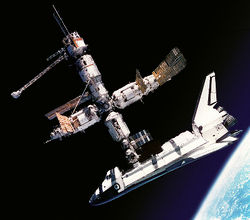
The International Space Station represents a union of several national space station projects that originated during the Cold War. In the early 1980s, NASA planned to launch a modular space station called Freedom as a counterpart to the Soviet Salyut and Mir space stations, while the Soviets were planning to construct Mir-2 in the 1990s as a replacement for Mir.[16] Because of budget and design constraints, Freedom never progressed past mock-ups and minor component tests.
With the fall of the Soviet Union and the end of the Space Race, Freedom was nearly cancelled by the United States House of Representatives. The post-Soviet economic chaos in Russia led to the cancellation of Mir-2, though only after its base block, DOS-8, had been constructed.[16] Similar budgetary difficulties were faced by other nations with space station projects, which prompted the American government to negotiate with European states, Russia, Japan, and Canada in the early 1990s to begin a collaborative project.[16]
In June 1992 American president George H. W. Bush and Russian president Boris Yeltsin agreed to cooperate on space exploration. The resulting Agreement between the United States of America and the Russian Federation Concerning Cooperation in the Exploration and Use of Outer Space for Peaceful Purposes called for a short, joint space programme, with one American astronaut deployed to the Russian space station Mir and two Russian cosmonauts deployed to a Space Shuttle.[16]
In September 1993, American Vice-President Al Gore, Jr., and Russian Prime Minister Viktor Chernomyrdin announced plans for a new space station, which eventually became the International Space Station.[40] They also agreed, in preparation for this new project, that the United States would be heavily involved in the Mir programme as part of an agreement that later included Space Shuttle orbiters docking with Mir.[18]
According to the plan, the International Space Station programme would combine the proposed space stations of all participant agencies: NASA's Freedom, the RSA's Mir-2 (with DOS-8 later becoming Zvezda), ESA's Columbus, and the Japanese Kibō laboratory. When the first module, Zarya, was launched in 1998, the station was expected to be completed by 2003. Delays have led to a revised estimated completion date of 2011.[41]
Station structure
Assembly
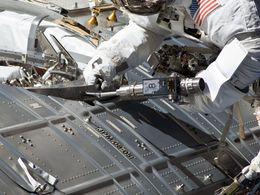
The assembly of the International Space Station, a major endeavour in space architecture, began in November 1998.[2] Astronauts install each element using spacewalks. By 27 November 2009, they had completed 136, totalling 849 hours of extra-vehicular activity (EVA), all devoted to assembly and maintenance of the station. Twenty-eight of these spacewalks originated from the airlocks of docked Space Shuttles; the remaining 108 were launched from the station.[1]
The first segment of the ISS, Zarya, was launched on 20 November 1998 on a Russian Proton rocket, followed two weeks later by Unity—the first of three node modules—which was launched aboard Space Shuttle flight STS-88. This bare two-module core of the ISS remained unmanned for the next one-and-a-half years. In July 2000 the Russian module Zvezda was added, allowing a maximum crew of three to occupy the ISS continuously. The first resident crew, Expedition 1, arrived in November 2000 on Soyuz TM-31, midway between the flights of STS-92 and STS-97. These two Space Shuttle flights each added segments of the station's Integrated Truss Structure, which provided the embryonic station with communications, guidance, electrical grounding (on Z1), and power via solar arrays located on the P6 truss.[42]
Over the next two years the station continued to expand. A Soyuz-U rocket delivered the Pirs docking compartment. The Space Shuttles Discovery, Atlantis, and Endeavour delivered the Destiny laboratory and Quest airlock, in addition to the station's main robot arm, the Canadarm2, and several more segments of the Integrated Truss Structure.[42]
The expansion schedule was interrupted by the destruction of the Space Shuttle Columbia on STS-107 in 2003, with the resulting hiatus in the Space Shuttle programme halting station assembly until the launch of Discovery on STS-114 in 2005.[43]
The official resumption of assembly was marked by the arrival of Atlantis, flying STS-115, which delivered the station's second set of solar arrays. Several more truss segments and a third set of arrays were delivered on STS-116, STS-117, and STS-118. As a result of the major expansion of the station's power-generating capabilities, more pressurised modules could be accommodated, and the Harmony node and Columbus European laboratory were added. These were followed shortly after by the first two components of Kibō. In March 2009, STS-119 completed the Integrated Truss Structure with the installation of the fourth and final set of solar arrays. The final section of Kibō was delivered in July 2009 on STS-127, followed by the Russian Poisk module. The third node, Tranquility, was delivered in February 2010 during STS-130 by the Space Shuttle Endeavour, alongside the Cupola, closely followed in May 2010 by the penultimate Russian module, Rassvet, delivered by Space Shuttle Atlantis on STS-132.
As of May 2010[update], the station consisted of fourteen pressurised modules and the complete Integrated Truss Structure. Still to be launched is the Pressurized Multipurpose Module Leonardo, the Russian Multipurpose Laboratory Module Nauka and a number of external components, including the European Robotic Arm and Alpha Magnetic Spectrometer (AMS-02). Assembly is expected to be completed by 2011, by which point the station will have a mass in excess of 400 metric tons (440 short tons).[2][41]
Pressurised modules
When completed, the ISS will consist of sixteen pressurised modules with a combined volume of around 1,000 cubic metres (35,000 cu ft). These modules include laboratories, docking compartments, airlocks, nodes and living quarters. Thirteen of these components are already in orbit, with the remaining three awaiting launch. Each module was or will be launched either by the Space Shuttle, Proton rocket or Soyuz rocket.[42]
| Module | Assembly mission | Launch date | Launch system | Nation | Isolated View | |
|---|---|---|---|---|---|---|
| Zarya (lit. 'dawn') (FGB) |
1A/R | 20 November 1998 | Proton-K | Russia (Builder) USA (Financier) |
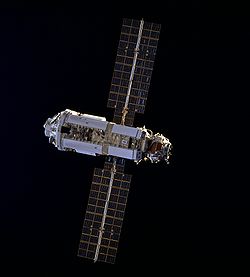 |
[44] |
| The first component of the ISS to be launched, Zarya provided electrical power, storage, propulsion, and guidance during initial assembly. The module now serves as a storage compartment, both inside the pressurised section and in the externally mounted fuel tanks. | ||||||
| Unity (Node 1) |
2A | 4 December 1998 | Space Shuttle Endeavour, STS-88 | USA |  |
[45] |
| The first node module, connecting the American section of the station to the Russian section (via PMA-1), and providing berthing locations for the Z1 truss, Quest airlock, Destiny laboratory and Tranquility node. | ||||||
| Zvezda (lit. 'star') (Service Module) |
1R | 12 July 2000 | Proton-K | Russia | 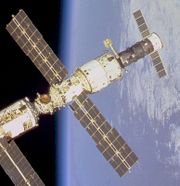 |
[46] |
| The station's service module, which provides the main living quarters for resident crews, environmental systems and attitude & orbit control. The module also provides docking locations for Soyuz spacecraft, Progress spacecraft and the Automated Transfer Vehicle, and its addition rendered the ISS permanently habitable for the first time. | ||||||
| Destiny (US Laboratory) |
5A | 7 February 2001 | Space Shuttle Atlantis, STS-98 | USA |  |
[47] |
| The primary research facility for US payloads aboard the ISS, Destiny is intended for general experiments. The module houses 24 International Standard Payload Racks, some of which are used for environmental systems and crew daily living equipment, and features a 51-centimetre (20 in) optically perfect window, the largest such window ever produced for use in space. Destiny also serves as the mounting point for most of the station's Integrated Truss Structure. | ||||||
| Quest (Joint Airlock) |
7A | 12 July 2001 | Space Shuttle Atlantis, STS-104 | USA |  |
[48] |
| The primary airlock for the ISS, Quest hosts spacewalks with both US EMU and Russian Orlan spacesuits. Quest consists of two segments; the equipment lock, that stores spacesuits and equipment, and the crew lock, from which astronauts can exit into space. | ||||||
| Pirs (lit. 'pier') (Docking Compartment) |
4R | 14 September 2001 | Soyuz-U, Progress M-SO1 | Russia |  |
[49] |
| Pirs provides the ISS with additional docking ports for Soyuz and Progress spacecraft, and allows egress and ingress for spacewalks by cosmonauts using Russian Orlan spacesuits, in addition to providing storage space for these spacesuits. | ||||||
| Harmony (Node 2) |
10A | 23 October 2007 | Space Shuttle Discovery, STS-120 | Europe (Builder) USA (Operator) |
 |
[50] |
| The second of the station's node modules, Harmony is the utility hub of the ISS. The module contains four racks that provide electrical power, bus electronic data, and acts as a central connecting point for several other components via its six Common Berthing Mechanisms (CBMs). The European Columbus and Japanese Kibō laboratories are permanently berthed to the module, and American Space Shuttle Orbiters dock with the ISS via PMA-2, attached to Harmony's forward port. In addition, the module serves as a berthing port for the Italian Multi-Purpose Logistics Modules during shuttle logistics flights. | ||||||
| Columbus (European Laboratory) |
1E | 7 February 2008 | Space Shuttle Atlantis, STS-122 | Europe |  |
[51][52] |
| The primary research facility for European payloads aboard the ISS, Columbus provides a generic laboratory as well as facilities specifically designed for biology, biomedical research and fluid physics. Several mounting locations are affixed to the exterior of the module, which provide power and data to external experiments such as the European Technology Exposure Facility (EuTEF), Solar Monitoring Observatory, Materials International Space Station Experiment, and Atomic Clock Ensemble in Space. A number of expansions are planned for the module to study quantum physics and cosmology. | ||||||
| Kibō Experiment Logistics Module (lit. 'hope' and 'wish' JEM–ELM) |
1J/A | 11 March 2008 | Space Shuttle Endeavour, STS-123 | Japan |  |
[53] |
| Part of the Kibō Japanese Experiment Module laboratory, the ELM provides storage and transportation facilities to the laboratory with a pressurised section to serve internal payloads. | ||||||
| Kibō Pressurised Module (JEM–PM) |
1J | 31 May 2008 | Space Shuttle Discovery, STS-124 | Japan |  |
[53][54] |
| Part of the Kibō Japanese Experiment Module laboratory, the PM is the core module of Kibō to which the ELM and Exposed Facility are berthed. The laboratory is the largest single ISS module and contains a total of 23 racks, including 10 experiment racks. The module is used to carry out research in space medicine, biology, Earth observations, materials production, biotechnology, and communications research. The PM also serves as the mounting location for an external platform, the Exposed Facility (EF), that allows payloads to be directly exposed to the harsh space environment. The EF is serviced by the module's own robotic arm, the JEM–RMS, which is mounted on the PM. | ||||||
| Poisk (lit. 'search') (Mini-Research Module 2) |
5R | 10 November 2009 | Soyuz-U, Progress M-MIM2 | Russia | [55][56] | |
| One of the Russian ISS components, MRM2 will be used for docking of Soyuz and Progress ships, as an airlock for spacewalks and as an interface for scientific experiments. | ||||||
| Tranquility (Node 3) |
20A | 8 February 2010 | Space Shuttle Endeavour, STS-130 | Europe (Builder) USA (Operator) |
[57][58] | |
| The third and last of the station's US nodes, Tranquility contains an advanced life support system to recycle waste water for crew use and generate oxygen for the crew to breathe. The node also provides four berthing locations for more attached pressurised modules or crew transportation vehicles, in addition to the permanent berthing location for the station's Cupola. | ||||||
| Cupola | 20A | 8 February 2010 | Space Shuttle Endeavour, STS-130 | Europe (Builder) USA (Operator) |
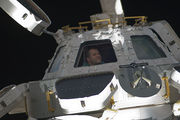 |
[59] |
| The Cupola is an observatory module that provides ISS crew members with a direct view of robotic operations and docked spacecraft, as well as an observation point for watching the Earth. The module comes equipped with robotic workstations for operating the SSRMS and shutters to protect its windows from damage caused by micrometeorites. | ||||||
| Rassvet (lit. 'dawn') (Mini-Research Module 1) |
ULF4 | 14 May 2010 | Space Shuttle Atlantis, STS-132 | Russia |  |
[41] |
| MRM1 is being used for docking and cargo storage aboard the station. | ||||||
Scheduled to be launched
| Module | Assembly mission | Launch date | Launch system | Nation | Isolated View | |
|---|---|---|---|---|---|---|
| Leonardo (Pressurized Multipurpose Module) |
ULF5 | NET 1 November 2010 | Space Shuttle Discovery, STS-133 | Italy (Builder) USA (Operator) |
 |
[60][61][62] |
| The Leonardo PMM will house spare parts and supplies, allowing longer times between resupply missions and freeing space in other modules, particularly Columbus. The PMM was created by converting the Italian Leonardo Multi-Purpose Logistics Module into a module that could be permanently attached to the station. The arrival of the module will mark the completion of the US Orbital Segment. | ||||||
| Nauka (lit. 'science') (Multipurpose Laboratory Module) |
3R | c. December 2011 | Proton-M | Russia |  |
[41][63] |
| The MLM will be Russia's primary research module as part of the ISS and will be used for general microgravity experiments, docking, and cargo logistics. The module provides a crew work and rest area, and will be equipped with a backup attitude control system that can be used to control the station's attitude. Based on the current assembly schedule, the arrival of Nauka will complete construction of the Russian Orbital Segment and it will be the last major component added to the station. | ||||||
Cancelled modules

Several modules planned for the station have been cancelled over the course of the ISS programme, whether for budgetary reasons, because the modules became unnecessary, or following a redesign of the station after the 2003 Columbia disaster. The cancelled modules include:
- The US Centrifuge Accommodations Module for experiments in varying levels of artificial gravity.[64]
- The US Habitation Module, which would have served as the station's living quarters. The sleep stations are now spread throughout the station.[65]
- The US Crew Return Vehicle would have served as the station's lifeboat; a service now provided by one Soyuz spacecraft for every three crew members aboard.[66]
- The US Interim Control Module and ISS Propulsion Module were intended to replace functions of Zvezda in case of a launch failure.[67]
- The Russian Universal Docking Module, to which the cancelled Russian Research modules and spacecraft would have docked.[68]
- The Russian Science Power Platform would have provided the Russian Orbital Segment with a power supply independent of the ITS solar arrays.[68]
- Two Russian Research Modules that were planned to be used for scientific research.[69]
Unpressurised elements
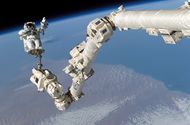
In addition to the pressurised modules, the ISS features a large number of external components. The largest component is the Integrated Truss Structure (ITS), to which the station's main solar arrays and thermal radiators are mounted.[19] The ITS consists of ten separate segments forming a structure 108.5 m (356 ft) long.[2]
The Alpha Magnetic Spectrometer (AMS), a particle physics experiment, is scheduled to be launched on STS-134 in 2011, and will be mounted externally on the ITS. The AMS will measure cosmic rays and look for evidence of dark matter and antimatter.[70]
The ITS serves as a base for the main remote manipulator system called the Mobile Servicing System (MSS). This consists of the Mobile Base System (MBS), the Canadarm2, and the Special Purpose Dexterous Manipulator. The MBS rolls along rails built into some of the ITS segments to allow the arm to reach all parts of the US segment of the station.[71] The MSS is due to have its reach increased by an Orbiter Boom Sensor System, scheduled for installation during the STS-133 mission.[72]
Two other remote manipulator systems are present in the station's final configuration. The European Robotic Arm, which will service the Russian Orbital Segment, will be launched alongside the Multipurpose Laboratory Module.[73] The JEM RMS, which services the JEM Exposed Facility,[74] was launched on STS-124 and is attached to the JEM Pressurised Module. In addition to these robotic arms, there are two Russian Strela cargo cranes used for moving spacewalking cosmonauts and parts around the exterior of the Russian Orbital Segment.[75]
The station in its complete form will have several smaller external components, such as the three External Stowage Platforms (ESPs), launched on STS-102, STS-114 and STS-118, which are used to store spare parts. Four ExPRESS Logistics Carriers (ELCs) will allow experiments to be deployed and conducted in the vacuum of space, and will provide the necessary electricity and computing to process experimental data locally. ELCs 1 and 2 were delivered on STS-129 in November 2009, and ELCs 3 and 4 are scheduled for delivery on STS-134 in November 2010 and STS-133 in September 2010.[41][76] There are two exposure facilities mounted directly to laboratory modules: the JEM Exposed Facility serves as an external 'porch' for the Japanese Experiment Module complex,[77] and a facility on the European Columbus laboratory provides power and data connections for experiments such as the European Technology Exposure Facility[78][79] and the Atomic Clock Ensemble in Space.[80]
Power supply
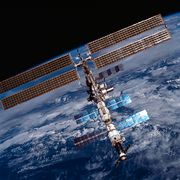
Photovoltaic (PV) arrays power the ISS. The Russian segment of the station, like the space shuttle and most aircraft, uses 28 volt DC partly provided by four solar arrays mounted directly to Zarya and Zvezda. The rest of the station uses 130-180 V DC from the US PV array arranged as four wing pairs. Each wing produces nearly 32.8 kW.[19]
Power is stabilised and distributed at 160 V DC and converted to the user-required 124 V DC. The higher distribution voltage allows smaller, lighter conductors. The two station segments share power with converters, essential since the cancellation of the Russian Science Power Platform made the Russian Orbital Segment dependent on the US arrays.[81]
The station uses rechargeable nickel-hydrogen batteries for continuous power during the 35 minutes of every 90 minute orbit that it is eclipsed by the Earth. The batteries are recharged on the day side of the earth. They have a 6.5 year lifetime (over 37,000 charge/discharge cycles) and will be regularly replaced over the anticipated 20-year life of the station.[82]
The US solar arrays normally track the sun to maximise power generation. Each array is about 375 m2 (450 yd2) in area and 58 metres (63 yd) long. In the complete configuration, the solar arrays track the sun by rotating the alpha gimbal once per orbit while the beta gimbal follows slower changes in the angle of the sun to the orbital plane. The Night Glider mode aligns the solar arrays parallel to the velocity vector at night to reduce the significant aerodynamic drag at the station's relatively low orbital altitude.[83]
Orbit control
.png)
The ISS is maintained in a near circular orbit with a minimum mean altitude of 278 km (173 mi) and a maximum of 460 km (286 mi). It travels at an average speed of 27,724 kilometres (17,227 mi) per hour, and completes 15.7 orbits per day.[84] The normal maximum altitude is 425 km (264 mi) to allow Soyuz rendezvous missions. As the ISS constantly loses altitude because of a slight atmospheric drag, it needs to be boosted to a higher altitude several times each year.[29][85] This boost can be performed by the station's two main engines on the Zvezda service module, a docked space shuttle, a Progress resupply vessel, or by ESA's ATV. It takes approximately two orbits (three hours) for the boost to a higher altitude to be completed.[85]
In December 2008 NASA signed an agreement with the Ad Astra Rocket Company which may result in the testing on the ISS of a VASIMR plasma propulsion engine.[86] This technology could allow station-keeping to be done more economically than at present.[87][88] The station's navigational position and velocity, or state vector, is independently established using the US Global Positioning System (GPS) and a combination of state vector updates from Russian Ground Sites and the Russian GLONASS system.
The attitude (orientation) of the station is independently determined by a set of sun, star and horizon sensors on Zvezda and the US GPS with antennas on the S0 truss and a receiver processor in the US lab. The attitude knowledge is propagated between updates by rate sensors.[22] Attitude control is maintained by either of two mechanisms; normally, a system of four control moment gyroscopes (CMGs) keeps the station oriented, with Destiny forward of Unity, the P truss on the port side, and Rassvet on the Earth-facing (nadir) side. When the CMG system becomes 'saturated'—when the set of CMGs exceed their operational range or cannot track a series of rapid movements—they can lose their ability to control station attitude.[89] In this event, the Russian attitude control system is designed to provide desaturating thruster firings, taking over automatically whilst the CMG system is reset. This automatic attitude control safing has only occurred once, during Expedition 10.[90] When a space shuttle is docked to the station, it can also be used to maintain station attitude. This occurs during portions of every mated shuttle ISS mission. Shuttle control was used exclusively during STS-117 as the S3/S4 truss was installed.[91]
Communications
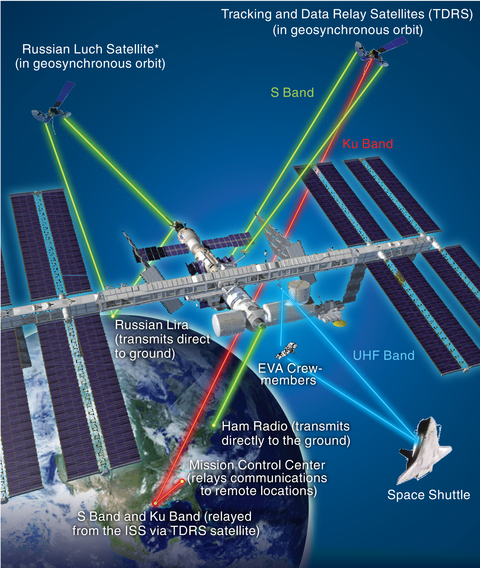
* Luch satellite not currently in use.
Radio communications provide telemetry and scientific data links between the station and Mission Control Centres. Radio links are also used during rendezvous and docking procedures and for audio and video communication between crewmembers, flight controllers and family members. As a result, the ISS is equipped with internal and external communication systems used for different purposes.[92]
The Russian Orbital Segment communicates directly with the ground via the Lira antenna mounted to Zvezda.[22][93] The Lira antenna also has the capability to use the Luch data relay satellite system.[22] This system, used for communications with Mir, fell into disrepair during the 1990s, and as a result is no longer in use,[16][22][94] although two new Luch satellites—Luch-5A and Luch-5B—are planned for launch in 2011 to restore the operational capability of the system.[95] Another Russian communications system is the Voskhod-M, which enables internal telephone communications between Zvezda, Zarya, Pirs, Poisk and the USOS, and also provides a VHF radio link to ground control centres via antennas on Zvezda's exterior.[96]
The US Orbital Segment (USOS) makes use of two separate radio links mounted in the Z1 truss structure: the S band (used for audio) and Ku band (used for audio, video and data) systems. These transmissions are routed via the US Tracking and Data Relay Satellite System (TDRSS) in geostationary orbit, which allows for almost continuous real-time communications with NASA's Mission Control Center (MCC-H) in Houston.[17][22][92] Data channels for the Canadarm2, European Columbus laboratory and Japanese Kibō modules are routed via the S band and Ku band systems, although the European Data Relay Satellite System and a similar Japanese system will eventually complement the TDRSS in this role.[17][97] Communications between modules are carried on an internal digital wireless network.[98]
UHF radio is used by astronauts and cosmonauts conducting EVAs. UHF is employed by other spacecraft that dock to or undock from the station, such as Soyuz, Progress, HTV-II, ATV and the Space Shuttle (except the shuttle also makes use of the S band and Ku band systems via TDRSS), to receive commands from Mission Control and ISS crewmembers.[22] Automated spacecraft are fitted with their own communications equipment; the ATV uses a laser attached to the spacecraft and equipment attached to Zvezda, known as the Proximity Communications Equipment, to accurately dock to the station.[99][100]
Microgravity
At the station's orbital altitude, the gravity from the Earth is 88% of that at sea level. While the constant free fall of the ISS offers a perceived sensation of weightlessness, the environment onboard is not one of weightlessness or zero-gravity. The environment on the station is, however, often described as microgravity. This is caused by four separate effects:[101]
- The drag resulting from the residual atmosphere.
- Vibratory acceleration caused by mechanical systems and the crew on board the ISS.
- Orbital corrections by the on-board gyroscopes or thrusters.
- The spatial separation from the real centre of mass of the ISS. Any part of the ISS not at the exact centre of mass will tend to follow its own orbit. However, as each point is physically part of the station, this is impossible, and so each component is subject to small accelerations from the forces which keep them attached to the station as it orbits.[101] This is also called the tidal force.
- The differences in orbital plane between different locations aboard the ISS.
Life support
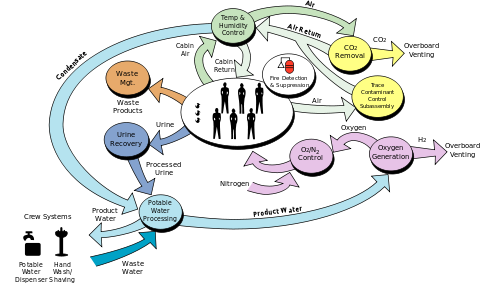
The ISS Environmental Control and Life Support System (ECLSS) provides or controls atmospheric pressure, fire detection and suppression, oxygen levels, waste management and water supply. The highest priority for the ECLSS is the ISS atmosphere, but the system also collects, processes, and stores waste and water produced and used by the crew—a process that recycles fluid from the sink, toilet, and condensation from the air. The Elektron system aboard Zvezda and a similar system in Destiny generate oxygen aboard the station.[102] The crew has a backup option in the form of bottled oxygen and Solid Fuel Oxygen Generation (SFOG) canisters.[103] Carbon dioxide is removed from the air by the Vozdukh system in Zvezda. Other by-products of human metabolism, such as methane from the intestines and ammonia from sweat, are removed by activated charcoal filters.[103]
The atmosphere on board the ISS is similar to the Earth's.[104] Normal air pressure on the ISS is 101.3 kPa (14.7 psi);[105] the same as at sea level on Earth. An Earth-like atmosphere offers benefits for crew comfort, and is much safer than the alternative, a pure oxygen atmosphere, because of the increased risk of a fire such as that responsible for the deaths of the Apollo 1 crew.[106]
Sightings
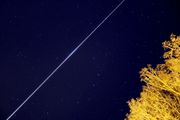
Because of the size of the ISS (about that of an American football field) and the large reflective area offered by its solar panels, ground based observation of the station is possible with the naked eye if the observer is in the right location at the right time. In many cases, the station is one of the brightest naked-eye objects in the sky, although it is visible only for periods ranging from two to five minutes.[8]
If the following conditions are fulfilled (assuming the weather is clear), the station will appear as a very bright object in the sky: The station must be above the observer's horizon, and it must pass within about 2,000 kilometres (1,200 mi) of the observation site (the closer the better). It must be dark enough at the observer's location for stars to be visible, and the station must be in sunlight rather than in the Earth's shadow. It is common for the third condition to begin or end during what would otherwise be a good viewing opportunity. In the evening, as the station moves further from the dusk, going from west to east it will appear to suddenly fade and disappear. In the reverse situation, it may suddenly appear in the sky as it approaches the dawn.[8][107] With the station's maximum brightness at approximately magnitude -5.9, it is bright enough to be spotted during broad daylight conditions without optical aid.[108][109][110]
Politics, utilisation and financing
Legal aspects

The ISS is a joint project of several space agencies: the US National Aeronautics and Space Administration (NASA), the Russian Federal Space Agency (RKA), the Japan Aerospace Exploration Agency (JAXA), the Canadian Space Agency (CSA) and the European Space Agency (ESA).[21]
As a multinational project, the legal and financial aspects are complex. Issues of concern include the ownership of modules, station utilisation by participant nations, and responsibilities for station resupply. Obligations and rights are established by the Space Station Intergovernmental Agreement (IGA). This international treaty was signed on 28 January 1998 by the primary nations involved in the Space Station project; the United States of America, Russian Federation, Japan, Canada and ten member states of the European Space Agency (Belgium, Denmark, France, Germany, Italy, The Netherlands, Norway, Spain, Sweden and Switzerland).[23] A second layer of agreements was then achieved, called Memoranda of Understanding (MOU), between NASA and ESA, CSA, RKA and JAXA. These agreements are then further split, such as for the contractual obligations between nations, and trading of partners' rights and obligations.[23] Use of the Russian Orbital Segment is also negotiated at this level.[24]
In addition to these main intergovernmental agreements, Brazil joins as a bilateral partner of the United States by a contract with NASA to supply hardware.[111] In return, NASA will provide Brazil with access to its ISS facilities on-orbit, as well as a flight opportunity for one Brazilian astronaut during the course of the ISS programme. Italy has a similar contract with NASA to provide comparable services, although Italy also takes part in the programme directly via its membership in ESA.[112] China has reportedly expressed interest in the project, especially if it would be able to work with the RKA. However, as of 2009[update] China is not involved because of US objections.[113][114] The heads of both the South Korean and Indian space agencies announced at the first plenary session of the 2009 International Astronautical Congress that their nations intend to join the ISS programme, with talks due to begin in 2010. The heads of agency also expressed support for extending ISS lifetime.[115]
Utilisation rights
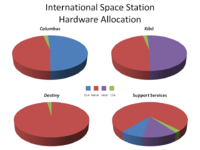
The Russian part of the station is operated and controlled by the Russian Federation's space agency and provides Russia with the right to nearly one-half of the crew time for the ISS. The allocation of remaining crew time (three to four crew members of the total permanent crew of six) and hardware within the other sections of the station has been assigned as follows:
- Columbus: 51% for the ESA, 46.7% for NASA, and 2.3% for CSA.[23]
- Kibō: 51% for the JAXA, 46.7% for NASA, and 2.3% for CSA.[97]
- Destiny: 97.7% for NASA and 2.3% for CSA.[116]
- Crew time, electrical power and rights to purchase supporting services (such as data upload and download and communications) are divided 76.6% for NASA, 12.8% for JAXA, 8.3% for ESA, and 2.3% for CSA.[23][97][116]
Costs
The cost estimates for the ISS range from 35 billion to 160 billion dollars.[26] ESA, the one agency which actually presents potential overall costs, estimates €100 billion for the entire station over 30 years.[25] A precise cost estimate for the ISS is unclear, as it is difficult to determine which costs should be attributed to the ISS programme, or how the Russian contribution should be measured.[26]
Criticism
Critics of the ISS contend that the time and money spent on the ISS could be better spent on other projects—whether they be robotic spacecraft missions, space exploration, investigations of problems on Earth, or just tax savings.[27][28] Some critics, such as Robert L. Park, argue that little scientific research was convincingly planned for the ISS, and that the primary feature of a space-based laboratory, its microgravity environment, can be studied less expensively with a "vomit comet".[27][117][118]
The research capabilities of the ISS have been criticised, particularly following the cancellation of the ambitious Centrifuge Accommodations Module, which, alongside other equipment cancellations, means scientific research performed on the station is generally limited to experiments which do not require any specialised apparatus. For example, in the first half of 2007, ISS research dealt primarily with human biological responses to living and working in space, covering topics like kidney stones, circadian rhythm, and the effects of cosmic rays on the nervous system.[119][120][121] Other criticisms hinge on the technical design of the ISS, including the high inclination of the station's orbit, which leads to a higher cost for US-based launches to the station.[122]
In response to some of these comments, advocates of manned space exploration say that criticism of the ISS project is short-sighted, and that manned space research and exploration have produced billions of dollars' worth of benefits. NASA has estimated that the indirect economic return from spin-offs of human space exploration has been many times the initial public investment, although this estimate is based on the Apollo Program and was made in the 1970s.[123] A review of the claims by the Federation of American Scientists argued that NASA's rate of return from spin-offs is actually very low, except for aeronautics work that has led to aircraft sales.[124]
End of mission and deorbit plans
NASA planned to deorbit the ISS in the first quarter of 2016.[125] However, the plan to end the ISS programme in 2015, as determined in 2004 by then-President George W. Bush, has been rejected by the current Obama administration. With the new budget announced on 1 February 2010, the administration aims to extend the lifetime through 2020. Current NASA administrator Charles Bolden has stated the lifetime of the ISS will be extended beyond 2016, the year that international funding for the station is planned to end.[126] The Augustine Commission, which reviewed NASA's human space flight program, recommended in its final report of 23 October 2009 the extension of the ISS programme to at least 2020.[127] In particular, Leroy Chiao, a former space station commander and space shuttle astronaut who sat on the advisory panel, stated in a CNN interview: “You've got all of these different countries working together on this common project in space. And if we go ahead and stop [...] it is going to break up that framework. The different countries around the world will lose confidence in the US as a leader in space exploration." NASA officials received confirmation from the Obama administration on the future direction of the ISS in particular and the human spaceflight programme in general on 1 February 2010, with a budget proposing an extension to the ISS programme until at least 2020,[7][128] with talks between ISS partners suggesting that the station could conceivably remain operational until 2025 or 2028.[129][130]
NASA has the responsibility to deorbit the ISS. Although Zvezda has a propulsion system used for station-keeping, it is not powerful enough for a controlled deorbit. Options for controlled deorbit of the ISS include the use of a modified European ATV or a specially constructed deorbit vehicle.[131][132]
According to a 2009 report, RKK Energia is considering methods to remove from the station some modules of the Russian Orbital Segment when the end of mission is reached and use them as a basis for a new station, known as the Orbital Piloted Assembly and Experiment Complex. The modules under consideration for removal from the current ISS include the Multipurpose Laboratory Module (MLM), currently scheduled to be launched at the end of 2011, with other Russian modules which are currently planned to be attached to the MLM until 2015, although still currently unfunded. Neither the MLM nor any additional modules attached to it would have reached the end of their useful lives in 2016 or 2020. The report presents a statement from an unnamed Russian engineer who believes that, based on the experience from Mir, a thirty-year life should be possible, except for micrometeorite damage, because the Russian modules have been built with on-orbit refurbishment in mind.[133]
Life on board
Crew schedule
The time zone used on board the ISS is Coordinated Universal Time (UTC). The windows are covered at night hours to give the impression of darkness because the station experiences 16 sunrises and sunsets a day. During visiting space shuttle missions, the ISS crew will mostly follow the shuttle's Mission Elapsed Time (MET), which is a flexible time zone based on the launch time of the shuttle mission.[134][135] Because the sleeping periods between the UTC time zone and the MET usually differ, the ISS crew often has to adjust its sleeping pattern before the space shuttle arrives and after it leaves to shift from one time zone to the other in a practice known as sleep shifting.[136]
A typical day for the crew begins with a wake-up at 06:00, followed by post-sleep activities and a morning inspection of the station. The crew then eats breakfast and takes part in a daily planning conference with Mission Control before starting work at around 08:10. The first scheduled exercise of the day follows, after which the crew continues work until 13:05. Following a one-hour lunch break, the afternoon consists of more exercise and work before the crew carries out its pre-sleep activities beginning at 19:30, including dinner and a crew conference. The scheduled sleep period begins at 21:30. In general, the crew works 10 hours per day on a weekday, and 5 hours on Saturdays, with the rest of the time their own for relaxation, games or work catch-up.[137]
Sleeping in space
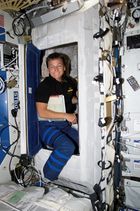
The station provides crew quarters for each member of permanent Expedition crews, with two 'sleep stations' in the Russian Orbital Segment and four more, due to be installed in Tranquility, currently spread around the USOS. The American quarters are private, approximately person-sized soundproof booths. A crewmember can sleep in them in a tethered sleeping bag, listen to music, use a laptop, and store personal effects in a large drawer or in nets attached to the module's walls. The module also provides a reading lamp, a shelf and a desktop.[138][139][140] Visiting crews have no allocated sleep module, and attach a sleeping bag to an available space on a wall—it is possible to sleep floating freely through the station, but this is generally avoided because of the possibility of bumping into sensitive equipment.[141] It is important that crew accommodations are well ventilated. Otherwise, astronauts can wake up oxygen deprived and gasping for air, because a bubble of their own exhaled carbon dioxide has formed around their heads.[140]
Hygiene
The ISS does not feature a shower, although it was planned as part of the now cancelled Habitation Module. Instead, crewmembers wash using a water jet and wet wipes, with soap dispensed from a toothpaste tube-like container. Crews are also provided with rinseless shampoo and edible toothpaste to save water.[141]
There are two space toilets on the ISS, both of Russian design, located in Zvezda and Tranquility.[138] These Waste and Hygiene Compartments use a fan-driven suction system similar to the Space Shuttle Waste Collection System. Astronauts first fasten themselves to the toilet seat, which is equipped with spring-loaded restraining bars to ensure a good seal.[140] A lever operates a powerful fan and a suction hole slides open: the air stream carries the waste away. Solid waste is collected in individual bags which are stored in an aluminium container. Full containers are transferred to Progress spacecraft for disposal.[138][142] Liquid waste is evacuated by a hose connected to the front of the toilet, with anatomically correct “urine funnel adapters” attached to the tube so both men and women can use the same toilet. Waste is collected and transferred to the Water Recovery System, where it is recycled back into drinking water.[139]
Food and drink
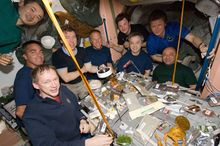
Most of the food eaten by station crews is frozen, refrigerated or canned. Menus are prepared by the astronauts, with the help of a dietitian, before the astronauts' flight to the station.[139] As the sense of taste is reduced in orbit because of fluid shifting to the head, spicy food is a favourite of many crews.[140] Each crewmember has individual food packages and cooks them using the onboard galley, which features two food warmers, a refrigerator, and a water dispenser that provides both heated and unheated water.[138] Drinks are provided in dehydrated powder form, and are mixed with water before consumption.[138][139] Drinks and soups are sipped from plastic bags with straws, while solid food is eaten with a knife and fork, which are attached to a tray with magnets to prevent them floating away. Any food which does float away, including crumbs, must be collected to prevent it from clogging up the station's air filters and other equipment.[139]
Exercise
The most significant adverse effects of long-term weightlessness are muscle atrophy and deterioration of the skeleton, or spaceflight osteopenia. Other significant effects include fluid redistribution, a slowing of the cardiovascular system, decreased production of red blood cells, balance disorders, and a weakening of the immune system. Lesser symptoms include loss of body mass, nasal congestion, sleep disturbance, excess flatulence, and puffiness of the face. These effects begin to reverse quickly upon return to the Earth.[34]
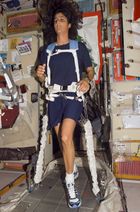
To prevent some of these adverse physiological effects, the station is equipped with two treadmills (including the COLBERT), the aRED (advanced Resistive Exercise Device) which enables various weightlifting exercises, and a stationary bicycle; each astronaut spends at least two hours per day exercising on the equipment.[138][140] Astronauts use bungee cords to strap themselves to the treadmill.[143] Researchers believe that exercise is a good countermeasure for the bone and muscle density loss that occurs when humans live for a long time without gravity.[144]
Station operations
Expeditions
Each permanent station crew is given a sequential expedition number. Expeditions have an average duration of half a year, and they commence following the official handover of the station from one Expedition commander to another. Expeditions 1 through 6 consisted of three person crews, but the Columbia accident led to a reduction to two crew members for Expeditions 7 to 12. Expedition 13 saw the restoration of the station crew to three, and the station has been permanently staffed as such since. While only three crew members are permanently on the station, several expeditions, such as Expedition 16, have consisted of up to six astronauts or cosmonauts, who are flown to and from the station on separate flights.[145][146]
On 27 May 2009, Expedition 20 began. Expedition 20 was the first ISS crew of six. Before the expansion of the living volume and capabilities from STS-115 the station could only host a crew of three. Expedition 20's crew was lifted to the station in two separate Soyuz-TMA flights launched at two different times (each Soyuz-TMA can hold only three people): Soyuz TMA-14 on 26 March 2009 and Soyuz TMA-15 on 27 May 2009. However, the station would not be permanently occupied by six crew members all year. For example, when the Expedition 20 crew (Roman Romanenko, Frank De Winne and Bob Thirsk) returned to Earth in November 2009, for a period of about two weeks only two crew members (Jeff Williams and Max Surayev) were aboard. This increased to five in early December, when Oleg Kotov, Timothy Creamer and Soichi Noguchi arrived on Soyuz TMA-17. It decreased to three when Williams and Surayev departed in March 2010, and finally returned to six in April 2010 with the arrival of Soyuz TMA-18, carrying Aleksandr Skvortsov, Mikhail Korniyenko and Tracy Caldwell Dyson.[145][146]
The International Space Station is the most-visited spacecraft in the history of space flight. As of 24 November 2009[update], it had received 266 visitors (185 different people).[9] Mir had 137 visitors (104 different people).[16]
Visiting spacecraft

Spacecraft from four different space agencies visit the ISS, serving a variety of purposes. The Automated Transfer Vehicle from the European Space Agency, the Russian Roskosmos Progress spacecraft and the HTV-II from the Japan Aerospace Exploration Agency have provided resupply services to the station. In addition, Russia supplies a Soyuz spacecraft used for crew rotation and emergency evacuation, which is replaced every six months. Finally, the US services the ISS through its Space Shuttle programme, providing resupply missions, assembly and logistics flights, and crew rotation. As of 27 November 2009[update], there have been 20 Soyuz, 35 Progress, 1 ATV, 1 HTV and 31 Space Shuttle flights to the station.[1] Expeditions require, on average, 2,722 kg of supplies, and as of 27 November 2009[update], crews had consumed a total of around 19,000 meals.[1] Soyuz crew rotation flights and Progress resupply flights visit the station on average two and three times respectively each year,[147] with the ATV and HTV planned to visit annually from 2010 onwards.
Following the retirement of the Space Shuttle, a number of other spacecraft are expected to fly to the station. Two, the Orbital Sciences Cygnus and SpaceX Dragon, will fly under NASA's Commercial Orbital Transportation Services and Commercial Resupply Services contracts, delivering cargo to the station until at least 2015.[148][149] In addition, the Orion spacecraft, developed as a Space Shuttle replacement as part of NASA's Constellation Programme, was retasked by President Barack Obama on 15 April 2010 to provide lifeboat services to the station.[150] The spacecraft had until that point been entirely cancelled under the US 2011 fiscal year budget.[151]
As of 4 July 2010[update], there are four spacecraft docked with the ISS:[147]
| Spacecraft | Mission | Docking port | Date docked (UTC) | Notes |
|---|---|---|---|---|
| Soyuz TMA-18 | Expedition 23/Expedition 24 | Poisk | 5 April 2010 05:24 | [15][152] |
| Progress M-05M | ISS Progress 37 | Pirs | 1 May 2010 18:30 | [153] |
| Soyuz TMA-19 | Expedition 24/Expedition 25 | Rassvet | 17 June 2010 21:21 | [154] |
Mission control centres

The components of the ISS are operated and monitored by their respective space agencies at control centres across the globe, including:
- NASA's Mission Control Center at Lyndon B. Johnson Space Center in Houston, Texas, serves as the primary control facility for the US segment of the ISS and also controls the Space Shuttle missions that visit the station.[22]
- NASA's Payload Operations and Integration Center at Marshall Space Flight Center in Huntsville, Alabama, serves as the centre that coordinates all payload operations in the US Segment.[22]
- Roskosmos's Mission Control Center at Korolyov, Moscow, controls the Russian Orbital Segment of the ISS, in addition to individual Soyuz and Progress missions.[22]
- ESA's Columbus Control Centre at the German Aerospace Centre (DLR) in Oberpfaffenhofen, Germany, controls the European Columbus research laboratory.[22]
- ESA's ATV Control Centre, at the Toulouse Space Centre (CST) in Toulouse, France, controls flights of the unmanned European Automated Transfer Vehicle.[22]
- JAXA's JEM Control Centre and HTV Control Centre at Tsukuba Space Centre (TKSC) in Tsukuba, Japan, are responsible for operating the Japanese Experiment Module complex and all flights of the unmanned Japanese HTV-II respectively.[22]
- CSA's MSS Control at Saint-Hubert, Quebec, Canada, controls and monitors the Mobile Servicing System, or Canadarm2.[22]
Safety aspects
Anomalies
Cooling loop A failure
Early on 1 August 2010, a failure in cooling Loop A (starboard side), one of two external cooling loops, left the station with only half of its normal cooling capacity and zero redundancy in some systems.[155][156][157] The problem appeared to be in the ammonia pump module that circulates the ammonia cooling fluid. Several subsystems, including two of the four CMGs, were shut down.
Planned operations on the ISS were interrupted through a series of EVAs to address the cooling system issue. A first EVA on 7 August 2010, to replace the failed pump module, was not fully completed due to an ammonia leak in one of four quick-disconnects. A second EVA on 11 August successfully removed the failed pump module.[158][159] A third EVA was required to restore Loop A to normal functionality.[160][161]
The station's cooling system is largely built by the American company Boeing,[162] which is also the manufacturer of the failed pump.[163]
Orbital debris
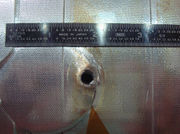
At the low altitudes at which the ISS orbits there is a variety of space debris, consisting of everything from entire spent rocket stages and defunct satellites, to explosion fragments, paint flakes, slag from solid rocket motors, coolant released by RORSAT nuclear powered satellites, small needles, and many other objects.[164] These objects, in addition to natural micrometeoroids,[165] pose a threat to the station as they have the ability to puncture the pressurised modules and cause damage to other parts of the station.[166][167] Micrometeoroids also pose a risk to spacewalking astronauts, as such objects could puncture their spacesuits, causing them to depressurise.[168]
Space debris objects are tracked remotely from the ground, and the station crew can be notified of many objects with sufficient size to cause damage on impact. This allows for a Debris Avoidance Manoeuvre (DAM) to be conducted, which uses thrusters on the Russian Orbital Segment to alter the station's orbital altitude, avoiding the debris. DAMs are not uncommon, taking place if computational models show the debris will approach within a certain threat distance.[166] Eight DAMs had been performed prior to March 2009,[169] the first seven between October 1999 and May 2003.[170] Usually the orbit is raised by one or two kilometres by means of an increase in orbital velocity of the order of 1 m/s. Unusually there was a lowering of 1.7 km on 27 August 2008, the first such lowering for 8 years.[170][171] There were two DAMs in 2009, on 22 March and 17 July.[172] If a threat from orbital debris is identified too late for a DAM to be safely conducted, the station crew close all the hatches aboard the station and retreat into their Soyuz spacecraft, so that they would be able to evacuate in the event it was damaged by the debris. This partial station evacuation has occurred twice, on 6 April 2003 and 13 March 2009.[166]
Radiation
Without the protection of the Earth's atmosphere, astronauts are exposed to higher levels of radiation from a steady flux of cosmic rays. The station's crews are exposed to about 1 millisievert of radiation each day, which is about the same as someone would get from natural sources on Earth in a year.[173] This results in a higher risk of astronauts' developing cancer. High levels of radiation can cause damage to the chromosomes of lymphocytes. These cells are central to the immune system and so any damage to them could contribute to the lowered immunity experienced by astronauts. Over time lowered immunity results in the spread of infection between crew members, especially in such confined areas. Radiation has also been linked to a higher incidence of cataracts in astronauts. Protective shielding and protective drugs may lower the risks to an acceptable level, but data is scarce and longer-term exposure will result in greater risks.[34]
Despite efforts to improve radiation shielding on the ISS compared to previous stations such as Mir, radiation levels within the station have not been vastly reduced, and it is thought that further technological advancement will be required to make long-duration human spaceflight further into the Solar System a possibility.[173]
It should be noted, however, that the radiation levels experienced on ISS are not excessively greater than those experienced by airline passengers. The Earth's electromagnetic field provides almost the same level of protection against solar and other radiation in Low Earth Orbit as in the stratosphere. Airline passengers, however, only experience this level of radiation for no more than 15 hours for the longest transcontinental flights (London-Sydney or Chicago-Delhi) and often far less time. For instance, a 12 hour flight from Boston to Beijing, an airline passenger would experience 0.1 millisievert of radiation, or a rate of 0.2 millisieverts per day, only 1/5th the rate experienced by an astronaut in LEO.[174]
References
- ↑ 1.0 1.1 1.2 1.3 NASA (27 November 2009). "The ISS to Date". NASA. http://spaceflight.nasa.gov/station/isstodate.html. Retrieved 28 November 2009.
- ↑ 2.0 2.1 2.2 2.3 NASA (18 February 2010). "On-Orbit Elements" (PDF). NASA. http://www.nasa.gov/externalflash/ISSRG/pdfs/on_orbit.pdf. Retrieved 19 June 2010.
- ↑ Chris Peat (18 June 2010). "ISS—Orbit Data". Heavens-Above.com. http://www.heavens-above.com/orbit.aspx?satid=25544. Retrieved 18 June 2010.
- ↑ Steven Siceloff (1 February 2001). "NASA Yields to Use of Alpha Name for Station". Florida Today. http://www.space.com/missionlaunches/missions/fl_alpha_010201.html. Retrieved 18 January 2009.
- ↑ "STS-132 Press Kit" (PDF). NASA. 7 May 2010. http://www.nasa.gov/pdf/451029main_sts132_press_kit.pdf. Retrieved 19 June 2010.
- ↑ Rand Simberg (29 July 2008). "The Uncertain Future of the International Space Station: Analysis". Popular Mechanics. http://www.popularmechanics.com/science/air_space/4275571.html. Retrieved 6 March 2009.
- ↑ 7.0 7.1 NASA (1 February 2010). "Statement by Charlie Bolden, NASA Budget Press Conference". Press release. http://www.nasa.gov/pdf/420994main_2011_Budget_Administrator_Remarks.pdf. Retrieved 1 February 2010.
- ↑ 8.0 8.1 8.2 NASA (2 July 2008). "International Space Station Sighting Opportunities". NASA. http://spaceflight.nasa.gov/realdata/sightings/index.html. Retrieved 28 January 2009.
- ↑ 9.0 9.1 9.2 9.3 "Nations Around the World Mark 10th Anniversary of International Space Station". NASA. 17 November 2008. http://www.nasa.gov/mission_pages/station/main/10th_anniversary.html. Retrieved 6 March 2009.
- ↑ 10.0 10.1 10.2 "International Space Station Overview". ShuttlePressKit.com. 3 June 1999. http://www.shuttlepresskit.com/ISS_OVR/index.htm. Retrieved 17 February 2009.
- ↑ 11.0 11.1 11.2 11.3 11.4 "Fields of Research". NASA. 26 June 2007. Archived from the original on 25 March 2008. http://web.archive.org/web/20080123150641/http://pdlprod3.hosc.msfc.nasa.gov/A-fieldsresearch/index.html.
- ↑ 12.0 12.1 "Getting on Board". NASA. 26 June 2007. Archived from the original on 8 December 2007. http://web.archive.org/web/20071208091537/http://pdlprod3.hosc.msfc.nasa.gov/B-gettingonboard/index.html.
- ↑ 13.0 13.1 13.2 "ISS Research Program". NASA. http://spaceflightsystems.grc.nasa.gov/Advanced/ISSResearch/. Retrieved 27 February 2009.
- ↑ "We've Only Just Begun". NASA. 26 June 2008. http://www.nasa.gov/mission_pages/station/main/5_year_anniversary.html. Retrieved 6 March 2009.
- ↑ 15.0 15.1 "Expedition 24". NASA. 15 June 2010. http://www.nasa.gov/mission_pages/station/expeditions/expedition24/index.html. Retrieved 18 June 2010.
- ↑ 16.0 16.1 16.2 16.3 16.4 16.5 16.6 16.7 16.8 David Harland (30 November 2004). The Story of Space Station Mir. New York: Springer-Verlag New York Inc. ISBN 978-0-387-23011-5. http://www.amazon.co.uk/exec/obidos/ASIN/0387230114/ref=ord_cart_shr/202-3649698-1866219?%5Fencoding=UTF8&m=A3P5ROKL5A1OLE.
- ↑ 17.0 17.1 17.2 17.3 John E. Catchpole (17 June 2008). The International Space Station: Building for the Future. Springer-Praxis. ISBN 978-0387781440.
- ↑ 18.0 18.1 Kim Dismukes (4 April 2004). "Shuttle–Mir History/Background/How "Phase 1" Started". NASA. http://spaceflight.nasa.gov/history/shuttle-mir/history/h-b-start.htm. Retrieved 12 April 2007.
- ↑ 19.0 19.1 19.2 "Spread Your Wings, It's Time to Fly". NASA. 26 July 2006. http://www.nasa.gov/mission_pages/station/behindscenes/truss_segment.html. Retrieved 21 September 2006.
- ↑ "See the ISS from your home town". ESA. 7 January 2009. http://www.esa.int/esaHS/ESA0I6KE43D_iss_0.html. Retrieved 18 June 2010.
- ↑ 21.0 21.1 "Human Spaceflight and Exploration—European Participating States". European Space Agency (ESA). 2009. http://www.esa.int/esaHS/partstates.html. Retrieved 17 January 2009.
- ↑ 22.00 22.01 22.02 22.03 22.04 22.05 22.06 22.07 22.08 22.09 22.10 22.11 22.12 22.13 22.14 22.15 Gary Kitmacher (2006). Reference Guide to the International Space Station. Canada: Apogee Books. pp. 71–80. ISBN 978-1-894959-34-6.
- ↑ 23.0 23.1 23.2 23.3 23.4 23.5 "ISS Intergovernmental Agreement". European Space Agency (ESA). 19 April 2009. http://www.spaceflight.esa.int/users/index.cfm?act=default.page&level=11&page=1980. Retrieved 19 April 2009.
- ↑ 24.0 24.1 "Memorandum of Understanding Between the National Aeronautics and Space Administration of the United States of America and the Russian Space Agency Concerning Cooperation on the Civil International Space Station". NASA. 29 January 1998. http://www.nasa.gov/mission_pages/station/structure/elements/nasa_rsa.html. Retrieved 19 April 2009.
- ↑ 25.0 25.1 "How Much Does It Cost?". European Space Agency (ESA). 9 August 2005. http://www.esa.int/esaHS/ESAQHA0VMOC_iss_0.html. Retrieved 27 March 2008.
- ↑ 26.0 26.1 26.2 Alan Boyle (25 August 2006). "What's the cost of the space station?". MSNBC. http://www.msnbc.msn.com/id/14505278/. Retrieved 30 September 2008.
- ↑ 27.0 27.1 27.2 Jim Wilson (December 2002). "Scientists Believe ISS Is Waste Of Money". Popular Mechanics. Hearst Corporation. http://www.popularmechanics.com/science/air_space/1282806.html. Retrieved 17 December 2009.
- ↑ 28.0 28.1 James P. Bagian et al. (2001). Readiness Issues Related to Research in the Biological and Physical Sciences on the International Space Station. United States National Academy of Sciences. http://www.nap.edu/catalog.php?record_id=10196.
- ↑ 29.0 29.1 29.2 James Oberg (2005). "International Space Station". World Book Online Reference Center. World Book, Inc. http://www.nasa.gov/worldbook/intspacestation_worldbook.html. Retrieved 14 June 2008.
- ↑ "The International Space Station: life in space". Science in School. 10 December 2008. http://www.scienceinschool.org/2008/issue10/iss. Retrieved 17 February 2009.
- ↑ Chris Bergin (22 August 2009). "ISS: Still in assembly, producing science research accomplishments". NASASpaceflight.com. http://www.nasaspaceflight.com/2009/08/iss-assembly-producing-science-research-accomplishments/. Retrieved 27 September 2009.
- ↑ Gro Mjeldheim Sandal and Dietrich Manzey (December 2009). "Cross-cultural issues in space operations: A survey study among ground personnel of the European Space Agency". Acta Astronautica 65 (11–12): 1520–1529. doi:10.1016/j.actaastro.2009.03.074.
- ↑ "NASA Authorization Act 2005". United States Government Printing Office. 30 December 2005. http://frwebgate.access.gpo.gov/cgi-bin/getdoc.cgi?dbname=109_cong_public_laws&docid=f:publ155.109.pdf. Retrieved 6 March 2009.
- ↑ 34.0 34.1 34.2 Jay Buckey (23 February 2006). Space Physiology. Oxford University Press USA. ISBN 978-0-19-513725-5. http://www.amazon.co.uk/Space-Physiology-Jay-C-Buckey/dp/0195137256/ref=sr_1_1?ie=UTF8&s=books&qisbn=1-227-46880-9&sr=8-1.
- ↑ List Grossman (24 July 2009). "Ion engine could one day power 39-day trips to Mars". New Scientist. http://www.newscientist.com/article/dn17476-ion-engine-could-one-day-power-39day-trips-to-mars.html?full=true. Retrieved 8 January 2010.
- ↑ Brooke Boen (1 May 2009). "Advanced Diagnostic Ultrasound in Microgravity (ADUM)". NASA. http://www.nasa.gov/mission_pages/station/science/experiments/ADUM.html. Retrieved 1 October 2009.
- ↑ Sishir Rao et al. (2008). "A Pilot Study of Comprehensive Ultrasound Education at the Wayne State University School of Medicine". Journal of Ultrasound in Medicine 27 (5): 745–749. PMID 18424650. http://www.jultrasoundmed.org/cgi/content/abstract/27/5/745.
- ↑ Michael Fincke et al. (2004). "Evaluation of Shoulder Integrity in Space: First Report of Musculoskeletal US on the International Space Station". Radiology 234 (234): 319–322. doi:10.1148/radiol.2342041680. PMID 15533948. http://radiology.rsna.org/content/234/2/319.abstract.
- ↑ "Materials Science 101". Science@NASA. 15 September 1999. http://science.nasa.gov/newhome/headlines/msad15sep99_1.htm. Retrieved 18 June 2009.
- ↑ Donna Heivilin (21 June 1994). "Space Station: Impact of the Expanded Russian Role on Funding and Research" (PDF). Government Accountability Office. http://archive.gao.gov/t2pbat3/151975.pdf. Retrieved 3 November 2006.
- ↑ 41.0 41.1 41.2 41.3 41.4 NASA (2008). "Consolidated Launch Manifest". NASA. http://www.nasa.gov/mission_pages/station/structure/iss_manifest.html. Retrieved 8 July 2008.
- ↑ 42.0 42.1 42.2 "HSF: ISS assembly sequence and on-orbit configuration". European Space Agency (ESA). http://esamultimedia.esa.int/multimedia/esa_iss_assembly_sequence/index_pop.html. Retrieved 6 March 2009.
- ↑ Chris Bergin (26 July 2005). "Discovery launches—The Shuttle is back". NASASpaceflight.com. http://www.nasaspaceflight.com/2005/07/discovery-launches-the-shuttle-is-back/. Retrieved 6 March 2009.
- ↑ "Zarya Module". NASA. 14 October 2008. http://www.nasa.gov/mission_pages/station/structure/elements/fgb.html. Retrieved 7 December 2009.
- ↑ "Unity Connecting Module: Cornerstone for a Home in Orbit". NASA. January 1999. http://spaceflight.nasa.gov/spacenews/factsheets/pdfs/unity.pdf. Retrieved 11 March 2009.
- ↑ "Zvezda Service Module". NASA. 11 March 2009. http://www.nasa.gov/mission_pages/station/structure/elements/sm.html. Retrieved 11 March 2009.
- ↑ "NASA—US Destiny Laboratory". NASA. 26 March 2007. http://www.nasa.gov/mission_pages/station/structure/elements/destiny.html. Retrieved 26 June 2007.
- ↑ "Space Station Extravehicular Activity". NASA. 4 April 2004. http://spaceflight.nasa.gov/station/eva/outside.html. Retrieved 11 March 2009.
- ↑ "Pirs Docking Compartment". NASA. 10 May 2006. http://www.nasa.gov/mission_pages/station/structure/elements/pirs.html. Retrieved 28 March 2009.
- ↑ "Harmony Node 2". NASA. 26 September 2007. http://www.nasa.gov/mission_pages/station/structure/elements/node2.html. Retrieved 28 March 2009.
- ↑ Chris Bergin (10 January 2008). "PRCB plan STS-122 for NET Feb 7—three launches in 10–11 weeks". NASASpaceflight.com. http://www.nasaspaceflight.com/2008/01/prcb-plan-sts-122-for-net-feb-7-three-launches-in-10-11-weeks/. Retrieved 12 January 2008.
- ↑ "Columbus laboratory". European Space Agency (ESA). 10 January 2009. http://www.esa.int/esaHS/ESAAYI0VMOC_iss_0.html. Retrieved 6 March 2009.
- ↑ 53.0 53.1 "NASA—Kibo Japanese Experiment Module". NASA. 23 November 2007. http://www.nasa.gov/mission_pages/station/structure/elements/jem.html. Retrieved 28 March 2009.
- ↑ "About Kibo". Japan Aerospace Exploration Agency (JAXA). 25 September 2008. http://kibo.jaxa.jp/en/about/. Retrieved 6 March 2009.
- ↑ Anatoly Zak. "Docking Compartment-1 and 2". RussianSpaceWeb.com. http://www.russianspaceweb.com/iss_dc.html. Retrieved 26 March 2009.
- ↑ Chris Bergin (10 November 2009). "Russian module launches via Soyuz for Thursday ISS docking". NASASpaceflight.com. http://www.nasaspaceflight.com/2009/11/live-russian-module-launch-towards-iss-on-soyuz/. Retrieved 10 November 2009.
- ↑ Robert Z. Pearlman (15 April 2009). "NASA Names Space Module After Moon Base, Not Stephen Colbert". Space.com. http://www.space.com/news/090414-colbert-space-station-node.html. Retrieved 15 April 2009.
- ↑ "Node 3: Connecting Module". European Space Agency (ESA). 23 February 2009. http://www.esa.int/esaHS/ESAFQL0VMOC_iss_0.html. Retrieved 28 March 2009.
- ↑ "Cupola". European Space Agency (ESA). 16 January 2009. http://www.esa.int/esaHS/ESA65K0VMOC_iss_0.html. Retrieved 28 March 2009.
- ↑ Chris Gebhardt (5 August 2009). "STS-133 refined to a five crew, one EVA mission—will leave MPLM on ISS". NASASpaceflight.com. http://www.nasaspaceflight.com/2009/08/sts-133-five-crew-one-eva-mission-leave-mpm-on-iss.
- ↑ Amos, Jonathan (29 August 2009). "Europe looks to buy Soyuz craft". BBC News. http://news.bbc.co.uk/2/hi/science/nature/8226309.stm.
- ↑ "Shuttle Q&A Part 5". NASASpaceflight.com. 27 September 2009. http://forum.nasaspaceflight.com/index.php?topic=17437.msg483604#msg483604. Retrieved 12 October 2009.
- ↑ "FGB-based Multipurpose Lab Module (MLM)". Khrunichev State Research and Production Space Centre. Archived from the original on 27 September 2007. http://web.archive.org/web/20070927002737/http://www.khrunichev.ru/khrunichev_eng/live/full_mks.asp?id=13190. Retrieved 31 October 2008.
- ↑ "Where is the Centrifuge Accommodation Module (CAM)?". NASASpaceflight.com. http://forum.nasaspaceflight.com/forums/thread-view.asp?tid=12560&mid=269666. Retrieved 12 October 2009.
- ↑ Tariq Malik (14 February 2006). "NASA Recycles Former ISS Module for Life Support Research". Space.com. http://www.space.com/missionlaunches/060214_iss_module.html. Retrieved 11 March 2009.
- ↑ E. D. Graf (February 2000). "The X-38 and Crew Return Vehicle Programmes" (PDF). ESA Bulletin 101. European Space Agency. http://esapub.esrin.esa.it/bulletin/bullet101/graf.pdf. Retrieved 4 October 2009.
- ↑ "ICM Interim Control Module". U.S. Naval Center for Space Technology. Archived from the original on 8 February 2007. http://web.archive.org/web/20070208164211/http://code8200.nrl.navy.mil/icm.html.
- ↑ 68.0 68.1 Anatoly Zak. "Russian segment of the ISS". russianspaceweb.com. http://www.russianspaceweb.com/iss_russia.html. Retrieved 3 October 2009.
- ↑ "Russian Research Modules". Boeing. http://www.boeing.com/defense-space/space/spacestation/components/russian_laboratory.html. Retrieved 21 June 2009.
- ↑ "The Alpha Magnetic Spectrometer Experiment". CERN. 21 January 2009. http://ams.cern.ch/. Retrieved 6 March 2009.
- ↑ "International Space Station". Canadian Space Agency. 9 March 2006. http://www.asc-csa.gc.ca/eng/iss/default.asp. Retrieved 4 October 2009.
- ↑ Chris Bergin (27 January 2009). "NASA approve funding to leave OBSS permanently on the ISS". NASASpaceflight.com. http://www.nasaspaceflight.com/2009/01/nasa-approve-leave-obss-permanently-on-iss/. Retrieved 5 October 2009.
- ↑ "ERA: European Robotic Arm". ESA. http://www.esa.int/esaHS/ESAQEI0VMOC_iss_0.html. Retrieved 4 October 2009.
- ↑ "Remote Manipulator System:About Kibo". JAXA. 29 August 2008. http://kibo.jaxa.jp/en/about/kibo/rms/. Retrieved 4 October 2009.
- ↑ "International Space Station Status Report #02-03". NASA. 14 January 2002. http://www.nasa.gov/centers/johnson/news/station/2002/iss02-03.txt. Retrieved 4 October 2009.
- ↑ "EXPRESS Racks 1 and 2 fact sheet". NASA. 12 April 2008. http://www.nasa.gov/centers/marshall/news/background/facts/expressrack.html. Retrieved 4 October 2009.
- ↑ "Exposed Facility:About Kibo". JAXA. 29 August 2008. http://kibo.jaxa.jp/en/about/kibo/jef/. Retrieved 9 October 2009.
- ↑ "NASA—European Technology Exposure Facility (EuTEF)". NASA. 6 October 2008. http://www.nasa.gov/mission_pages/station/science/experiments/EuTEF.html. Retrieved 28 February 2009.
- ↑ "ESA—Columbus—European Technology Exposure Facility (EuTEF)". ESA. 13 January 2009. http://www.esa.int/esaMI/Columbus/SEM7ZTEMKBF_0.html. Retrieved 28 February 2009.
- ↑ "Atomic Clock Ensemble in Space (ACES)". ESA. http://www.spaceflight.esa.int/projects/index.cfm?act=default.page&level=12&page=829. Retrieved 9 October 2009.
- ↑ "Boeing: Integrated Defense Systems—NASA Systems—International Space Station—Solar Power". Boeing. 2 November 2006. http://www.boeing.com/defense-space/space/spacestation/systems/solar_arrays.html. Retrieved 28 January 2009.
- ↑ Thomas B. Miller (24 April 2000). "Nickel-Hydrogen Battery Cell Life Test Program Update for the International Space Station". NASA. http://www.grc.nasa.gov/WWW/RT/RT1999/5000/5420miller.html. Retrieved 27 November 2009.
- ↑ G. Landis & C-Y. Lu (1991). "Solar Array Orientation Options for a Space Station in Low Earth Orbit". Journal of Propulsion and Power 7 (1): 123–125. doi:10.2514/3.23302.
- ↑ NASA (15 December 2008). "Current ISS Tracking data". NASA. http://spaceflight.nasa.gov/realdata/tracking/index.html. Retrieved 28 January 2009.
- ↑ 85.0 85.1 "ISS Environment". Johnson Space Center. Archived from the original on 13 February 2008. http://web.archive.org/web/20080213164432/http://pdlprod3.hosc.msfc.nasa.gov/D-aboutiss/D6.html. Retrieved 15 October 2007.
- ↑ "Press Release 121208" (pdf). AdAstra Rocket Company. 12 December 2008. http://www.adastrarocket.com/AdAstra-NASA_PR12Dec08.pdf. Retrieved 7 December 2009.
- ↑ "Propulsion Systems of the Future". NASA. http://www.nasa.gov/vision/space/travelinginspace/future_propulsion.html. Retrieved 29 May 2009.
- ↑ David Shiga (5 October 2009). "Rocket company tests world's most powerful ion engine". New Scientist. http://www.newscientist.com/article/dn17918-rocket-company-tests-worlds-most-powerful-ion-engine.html. Retrieved 7 October 2009.
- ↑ Carlos Roithmayr (2003). Dynamics and Control of Attitude, Power, and Momentum for a Spacecraft Using Flywheels and Control Moment Gyroscopes. Langley Research Center: NASA. http://www.amazon.co.uk/Dynamics-Attitude-Spacecraft-Flywheels-Gyroscopes/dp/B0018V9YG6/ref=sr_1_1?ie=UTF8&s=books&qid=1236365448&sr=8-1.
- ↑ "International Space Station Status Report #05-7". NASA. 11 February 2005. http://spaceflight.nasa.gov/spacenews/reports/issreports/2005/iss05-7.html. Retrieved 23 November 2008.
- ↑ Chris Bergin (14 June 2007). "Atlantis ready to support ISS troubleshooting". NASASPaceflight.com. http://www.nasaspaceflight.com/2007/06/atlantis-ready-to-support-iss-troubleshooting/. Retrieved 6 March 2009.
- ↑ 92.0 92.1 "Communications and Tracking". Boeing. Archived from the original on June 11, 2008. http://web.archive.org/web/20080611115319/http://www.boeing.com/defense-space/space/spacestation/systems/communications_tracking.html. Retrieved 30 November 2009.
- ↑ Mathews, Melissa; James Hartsfield (25 March 2005). "International Space Station Status Report: SS05-015". NASA News. NASA. http://www.nasa.gov/home/hqnews/2005/mar/HQ_ss05015_ISS_status_report.html. Retrieved 11 January 2010.
- ↑ Harvey, Brian (2007). The rebirth of the Russian space program: 50 years after Sputnik, new frontiers. Springer Praxis Books. pp. 263. ISBN 0387713549.
- ↑ Anatoly Zak (4 January 2010). "Space exploration in 2011". RussianSpaceWeb. http://www.russianspaceweb.com/2011.html. Retrieved 12 January 2010.
- ↑ "ISS On-Orbit Status 05/02/10". NASA. 2 May 2010. http://www.nasa.gov/directorates/somd/reports/iss_reports/2010/05022010.html. Retrieved 7 July 2010.
- ↑ 97.0 97.1 97.2 "Memorandum of Understanding Between the National Aeronautics and Space Administration of the United States of America and the Government of Japan Concerning Cooperation on the Civil International Space Station". NASA. 24 February 1998. http://www.nasa.gov/mission_pages/station/structure/elements/nasa_japan.html. Retrieved 19 April 2009.
- ↑ "Operations Local Area Network (OPS LAN) Interface Control Document" (PDF). NASA. February 2000. http://www.spaceref.com/iss/computer/iss.ops.lan.icd.pdf. Retrieved 30 November 2009.
- ↑ "ISS/ATV communication system flight on Soyuz". EADS Astrium. 28 February 2005. http://www.spaceref.com/news/viewpr.html?pid=16247. Retrieved 30 November 2009.
- ↑ Chris Bergin (10 November 2009). "STS-129 ready to support Dragon communication demo with ISS". NASASpaceflight.com. http://www.nasaspaceflight.com/2009/11/sts-129-support-dragon-communication-demo-iss/. Retrieved 30 November 2009.
- ↑ 101.0 101.1 "European Users Guide to Low Gravity Platforms" (PDF). European Space Agency. 6 December 2005. http://www.spaceflight.esa.int/users/downloads/userguides/physenv.pdf. Retrieved 16 May 2006.
- ↑ Tariq Malik (15 February 2006). "Air Apparent: New Oxygen Systems for the ISS". Space.com. http://www.space.com/businesstechnology/060215_techwed_iss_oxygen.html. Retrieved 21 November 2008.
- ↑ 103.0 103.1 Patrick L. Barry (13 November 2000). "Breathing Easy on the Space Station". NASA. http://science.nasa.gov/headlines/y2000/ast13nov_1.htm. Retrieved 21 November 2008.
- ↑ Craig Freudenrich (20 November 2000). "How Space Stations Work". Howstuffworks. http://science.howstuffworks.com/space-station2.htm. Retrieved 23 November 2008.
- ↑ "5–8: The Air Up There". NASAexplores. NASA. Archived from the original on 14 November 2006. http://web.archive.org/web/20061114010931/http://www.nasaexplores.com/show2_5_8a.php?id=04-032&gl=58. Retrieved 31 October 2008.
- ↑ Clinton Anderson; et. al. (30 January 1968). Report of the Committee on Aeronautical and Space Sciences, United States Senate—Apollo 204 Accident. Washington, DC: US Government Printing Office. pp. 8. http://klabs.org/richcontent/Reports/Failure_Reports/as-204/senate_956/as204_senate_956.pdf.
- ↑ European Space Agency (7 January 2009). "See the ISS from your home town". European Space Agency. http://www.esa.int/esaHS/ESA0I6KE43D_iss_0.html. Retrieved 13 November 2007.
- ↑ "ISS - Information". Heavens-Above.com. http://www.heavens-above.com/satinfo.aspx?satid=25544&lat=0&lng=0&loc=Unspecified&alt=0&tz=CET. Retrieved 8 July 2010.
- ↑ Harold F. Weaver (1947). "The Visibility of Stars Without Optical Aid". Publications of the Astronomical Society of the Pacific 59 (350).
- ↑ Spaceweather.com (5 June 2009). "ISS visible during the daytime". Spaceweather.com. http://spaceweather.com/archive.php?view=1&day=05&month=06&year=2009. Retrieved 5 June 2009.
- ↑ "NASA Signs International Space Station Agreement With Brazil". NASA. 14 October 1997. http://www.nasa.gov/centers/johnson/news/releases/1996_1998/h97-233.html. Retrieved 18 January 2009.
- ↑ "International Space Station (ISS)". Italian Space Agency. 18 January 2009. http://www.asi.it/en/flash_en/living/the_international_space_station_iss. Retrieved 18 January 2009.
- ↑ "China wants role in space station". Associated Press. CNN. 16 October 2007. Archived from the original on 14 March 2008. http://web.archive.org/web/20080314104006/http://www.cnn.com/2007/TECH/space/10/16/china.space.ap/index.html. Retrieved 20 March 2008.
- ↑ James Oberg (26 October 2001). "China takes aim at the space station". MSNBC. http://www.msnbc.msn.com/id/3077826/. Retrieved 30 January 2009.
- ↑ "South Korea, India to begin ISS partnership talks in 2010". Flight International. 19 June 2010. http://www.flightglobal.com/articles/2009/10/14/333406/south-korea-india-to-begin-iss-partnership-talks-in.html. Retrieved 14 October 2009.
- ↑ 116.0 116.1 "Memorandum of Understanding Between the National Aeronautics and Space Administration of the United States of America and the Canadian Space Agency Concerning Cooperation on the Civil International Space Station". NASA. 29 January 1998. http://www.nasa.gov/mission_pages/station/structure/elements/nasa_csa.html. Retrieved 19 April 2009.
- ↑ Robert L. Park. "Space Station: Maybe They Could Use It to Test Missile Defense". University of Maryland. http://bobpark.physics.umd.edu/WN04/wn092404.html. Retrieved 23 March 2009.
- ↑ Bob Park. "Space: International Space Station Unfurls New Solar Panels". University of Maryland. http://bobpark.physics.umd.edu/WN06/wn091506.html. Retrieved 15 June 2007.
- ↑ NASA (2007). "Renal Stone Risk During Spaceflight: Assessment and Countermeasure Validation (Renal Stone)". NASA. http://www.nasa.gov/mission_pages/station/science/experiments/Renal-Stone.html. Retrieved 13 November 2007.
- ↑ NASA (2007). "Sleep-Wake Actigraphy and Light Exposure During Spaceflight-Long (Sleep-Long)". NASA. http://www.nasa.gov/mission_pages/station/science/experiments/Sleep-Long.html. Retrieved 13 November 2007.
- ↑ NASA (2007). "Anomalous Long Term Effects in Astronauts' Central Nervous System (ALTEA)". NASA. http://www.nasa.gov/mission_pages/station/science/experiments/ALTEA.html. Retrieved 13 November 2007.
- ↑ James J. Secosky, George Musser (1996). "Up, Up, and Away". Astronomical Society of the Pacific. http://www.astrosociety.org/education/publications/tnl/34/space2.html. Retrieved 10 September 2006.
- ↑ E. Ginzburg, J.W. Kuhn, J. Schnee & B. Yavitz (1976). "Economic impact of large public programs The NASA experience". NASA Technical Reports Server (NTRS). http://ntrs.nasa.gov/index.jsp?method=order&oaiID=19760016995. Retrieved 13 November 2007.
- ↑ Federation of American Scientists. "NASA Technological Spinoff Fables". Federation of American Scientists. http://www.fas.org/spp/eprint/jp_950525.htm. Retrieved 17 September 2006.
- ↑ Achenbach, Joel (13 July 2009). "As Space Station Nears Completion, It Faces End of Mission". The Washington Post. http://www.washingtonpost.com/wp-dyn/content/article/2009/07/12/AR2009071201977.html. Retrieved 18 July 2009.
- ↑ "New NASA boss: Astronauts on Mars in his lifetime". ABC News. 21 July 2009. http://abcnews.go.com/Technology/wireStory?id=8140312. Retrieved 7 December 2009.
- ↑ Gen. Norman Augustine, et al. (23 October 2009). "Seeking a Human Spaceflight Program Worthy of a Great Nation". Review of US Human Space Flight Plans Committee/NASA. http://www.nasa.gov/pdf/396093main_HSF_Cmte_FinalReport.pdf. Retrieved 6 December 2009.
- ↑ Rich Phillips (14 October 2009). "How much longer will the space station fly?". CNN. http://www.cnn.com/2009/TECH/space/10/12/space.station.future/index.html. Retrieved 14 October 2009.
- ↑ Stephen Clark (11 March 2010). "Space station partners set 2028 as certification goal". Spaceflight Now. http://spaceflightnow.com/news/n1003/11station/. Retrieved 14 March 2010.
- ↑ Chris Bergin (8 July 2010). "ISS partners asked to assess Station extension to 2025 – potentially 2028". NASASpaceflight.com. http://www.nasaspaceflight.com/2010/07/iss-partners-assess-extension-2025-potentially-2028/. Retrieved 8 July 2010.
- ↑ Rob Coppinger (7 March 2007). "NASA may buy ESA's ATV to de-orbit ISS at end of life". Flightglobal. http://www.flightglobal.com/articles/2007/07/03/215291/nasa-may-buy-esas-atv-to-de-orbit-iss-at-end-of-life.html. Retrieved 27 September 2009.
- ↑ Thomas Kelly, et al. (2000). Engineering Challenges to the Long-Term Operation of the International Space Station. National Academies Press. pp. 28–30. ISBN 0-309-06938-6. http://search.nap.edu/openbook.php?record_id=9794&page=28.
- ↑ "Russia 'to save its ISS modules'". BBC News. 22 May 2009. http://news.bbc.co.uk/2/hi/science/nature/8064060.stm. Retrieved 23 May 2009.
- ↑ "Mission Elapsed Time explained". NASA. 13 September 1995. Archived from the original on November 15, 2007. http://web.archive.org/web/20071115223702/http://science.nasa.gov/Realtime/Rocket_Sci/clocks/time-met.html. Retrieved 9 November 2007.
- ↑ "Ask the STS-113 crew: Question 14". NASA. 7 December 2002. http://spaceflight.nasa.gov/feedback/expert/answer/crew/sts-113/index_2.html. Retrieved 9 November 2007.
- ↑ "STS-113 Mission and Expedition Crew Question and Answer Board". NASA. November 2002. http://www.nasa.gov/missions/highlights/webcasts/shuttle/sts113/mission-crew-qa.html. Retrieved 24 February 2009.
- ↑ "ISS Crew Timeline" (PDF). NASA. 5 November 2008. http://www.nasa.gov/pdf/287386main_110508_tl.pdf. Retrieved 5 November 2008.
- ↑ 138.0 138.1 138.2 138.3 138.4 138.5 Cheryl L. Mansfield (7 November 2008). "Station Prepares for Expanding Crew". NASA. http://www.nasa.gov/mission_pages/station/behindscenes/126_payload.html. Retrieved 17 September 2009.
- ↑ 139.0 139.1 139.2 139.3 139.4 "Living and Working on the International Space Station". CSA. http://www.asc-csa.gc.ca/pdf/educator-liv_wor_iss.pdf. Retrieved 28 October 2009.
- ↑ 140.0 140.1 140.2 140.3 140.4 "Daily life". ESA. 19 July 2004. http://www.esa.int/esaHS/ESAH1V0VMOC_astronauts_0.html. Retrieved 28 October 2009.
- ↑ 141.0 141.1 Tariq Malik (27 July 2009). "Sleeping in Space is Easy, But There's No Shower". Space.com. http://www.space.com/missionlaunches/090827-sts127-space-sleeping.html. Retrieved 29 October 2009.
- ↑ Ed Lu (8 September 2003). ""Greetings Earthling"". NASA. http://spaceflight.nasa.gov/station/crew/exp7/luletters/lu_letter9.html. Retrieved 1 November 2009.
- ↑ "Bungee Cords Keep Astronauts Grounded While Running". NASA. 16 June 2009. http://www.nasa.gov/mission_pages/station/behindscenes/bungee_running.html. Retrieved 23 August 2009.
- ↑ Amiko Kauderer (19 August 2009). "Do Tread on Me". NASA. http://www.nasa.gov/mission_pages/station/behindscenes/colbert_feature.html. Retrieved Augist 23, 2009.
- ↑ 145.0 145.1 "International Space Station Expeditions". NASA. 10 April 2009. http://www.nasa.gov/mission_pages/station/expeditions/index.html. Retrieved 13 April 2009.
- ↑ 146.0 146.1 NASA (2008). "International Space Station". NASA. http://www.nasa.gov/mission_pages/station/main/index.html. Retrieved 22 October 2008.
- ↑ 147.0 147.1 "Live listing of spacecraft operations". NASA. 1 December 2009. http://www.nasa.gov/mission_pages/station/resupply/index.html. Retrieved 8 December 2009.
- ↑ Space Operations Mission Directorate (30 August 2006). "Human Space Flight Transition Plan". NASA. http://www.hq.nasa.gov/osf/tran_plan.pdf.
- ↑ NASA (18 January 2006). "NASA Seeks Proposals for Crew and Cargo Transportation to Orbit". Press release. http://www.spaceref.com/news/viewpr.html?pid=18791. Retrieved 21 November 2006.
- ↑ Barack Obama. "Remarks By the President on Space Exploration in the 21st Centure" John F. Kennedy Space Center (15 April 2010). Retrieved on 5 May 2010.
- ↑ "Fiscal Year 2011 Budget Estimates". NASA. http://www.nasa.gov/pdf/420990main_FY_201_%20Budget_Overview_1_Feb_2010.pdf. Retrieved 7 March 2010.
- ↑ Chris Bergin (1 April 2010). "LIVE: Soyuz TMA-18 launches towards an over-stowed ISS". NASASpaceflight.com. http://www.nasaspaceflight.com/2010/04/live-soyuz-tma-18-set-to-launch-towards-an-over-stowed-iss/. Retrieved 23 December 2009.
- ↑ Chris Bergin (1 May 2010). "Progress M-05M replenishes ISS – NTA back to full working order". NASASpaceflight.com. http://www.nasaspaceflight.com/2010/05/progress-m-05m-replenishes-iss-nta-full-working-order/. Retrieved 4 May 2010.
- ↑ Chris Bergin. "Soyuz TMA-19 relocated as ISS managers discuss Node 4 addition". NASASpaceflight.com. http://www.nasaspaceflight.com/2010/06/soyuz-tma-19-relocated-iss-discuss-node-4-addition/. Retrieved 2010-06-29.
- ↑ "Problem forces partial powerdown aboard station"
- ↑ "NASA ISS On-Orbit Status 1 August 2010 (early edition)"
- ↑ "ISS Active Control System"
- ↑ Spaceflight Now "Wednesday spacewalk to remove failed coolant pump"
- ↑ NASA spaceflight Aug 11 "Large success for second EVA as failed Pump Module is removed"
- ↑ Spaceflight Now Aug 12 "Station's bad pump removed; more spacewalking ahead"
- ↑ Spaceflight Now, Aug 18 ISS cooling configuration returning to normal confirming ETCS PM success
- ↑ "Cooling System Malfunction Highlights Space Station's Complexity". Space.com. 2010-08-02. http://www.space.com/businesstechnology/international-space-station-complexities-100802.html.
- ↑ "Spacewalks needed to fix station cooling problem". Spaceflightnow. 2010-07-31. http://spaceflightnow.com/news/n1007/31station/.
- ↑ Michael Hoffman (3 April 2009). "National Space Symposium 2009:It's getting crowded up there". Defense News. http://defensenews.com/blogs/space-symposium/2009/04/03/its-getting-crowded-up-there/#more-155. Retrieved 7 October 2009.
- ↑ F. L. Whipple (1949). "The Theory of Micrometeoroids". Popular Astronomy 57: 517. http://adsabs.harvard.edu/full/1949PA.....57..517W.
- ↑ 166.0 166.1 166.2 Chris Bergin (30 September 2009). "Soyuz TMA-16 launches for journey to ISS—Safe Haven evaluations". NASASpaceflight.com. http://www.nasaspaceflight.com/2009/09/soyuz-tma-16-launch-to-iss-safe-haven-evaluations/. Retrieved 7 October 2009.
- ↑ Henry Nahra (24–29 April 1989). "Effect of Micrometeoroid and Space Debris Impacts on the Space Station Freedom Solar Array Surfaces". NASA. http://ntrs.nasa.gov/archive/nasa/casi.ntrs.nasa.gov/19890016664_1989016664.pdf. Retrieved 7 October 2009.
- ↑ Leonard David (7 January 2002). "Space Junk and ISS: A Threatening Problem". Space.com. http://www.space.com/missionlaunches/junk_iss_020107.html. Retrieved 30 November 2008.
- ↑ Rachel Courtland (16 March 2009). "Space station may move to dodge debris". New Scientist. http://www.newscientist.com/article/dn16777-space-station-may-move-to-dodge-debris.html. Retrieved 20 April 2010.
- ↑ 170.0 170.1 "ISS Maneuvers to Avoid Russian Fragmentation Debris". Orbital Debris Quarterly News (NASA) 12 (4): 1&2. October 2008. http://www.orbitaldebris.jsc.nasa.gov/newsletter/pdfs/ODQNv12i4.pdf. Retrieved 20 April 2010.
- ↑ "ATV carries out first debris avoidance manoeuvre for the ISS". ESA. 28 August 2008. http://www.esa.int/esaMI/ATV/SEM64X0SAKF_0.html. Retrieved 26 February 2010.
- ↑ "Avoiding satellite collisions in 2009.". Orbital Debris Quarterly News (NASA) 14 (1): 2. January 2010. http://www.orbitaldebris.jsc.nasa.gov/newsletter/pdfs/ODQNv14i1.pdf. Retrieved 20 April 2010.
- ↑ 173.0 173.1 Eugenie Samuel (23 October 2002). "Space station radiation shields 'disappointing'". New Scientist. http://www.newscientist.com/article/dn2956-space-station-radiation-shields-disappointing.html. Retrieved 7 October 2009.
- ↑ "Galactic Radiation Received in Flight". FAA Civil Aeromedical Institute. http://jag.cami.jccbi.gov./cariprofile.asp. Retrieved 20 May 2010.
External links
| Wikinews has news related to:
International Space Station
|
- Official International Space Station webpages of the participating space agencies
- NASA
- RSC Energia
- Russian Federal Space Agency
- Canadian Space Agency
- European Space Agency
- Japanese Space Agency
- Italian Space Agency
- Brazilian Space Agency (in Portuguese, archived version)
- Interactive and multimedia
- NASA's ISS interactive reference guide
- NASA's ISS image gallery search page
- Current position of the ISS
- ISS WebCam
- interactive ISS construction history from USA Today
- Experiments and science
- ESA - Columbus
- JAXA - Space Environment Utilization and Space Experiment
- NASA - Station Science
- RSC Energia - Science Research on ISS Russian Segment
|
||||||||||||||||||||||||||||||||||||||
|
|||||||||||||||||
|
||||||||||||||||||||||||||||||||||||||||||
|
||||||||||||||||
|
|||||||||||
|
|||||||||||||||||||||||||||||||||||||||

